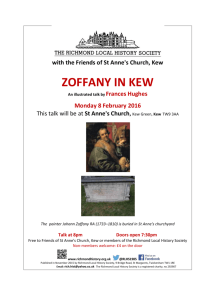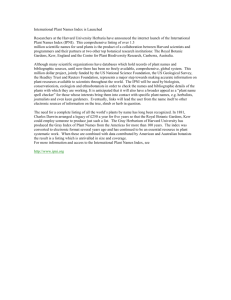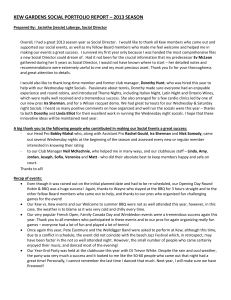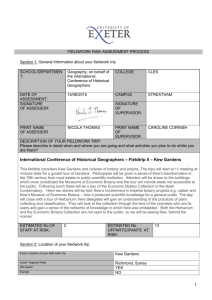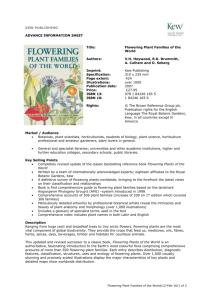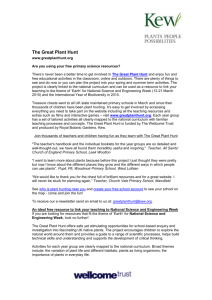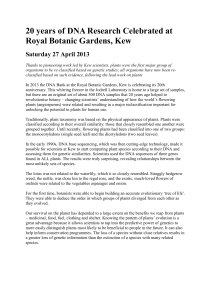Kew and Strand on the Green
advertisement
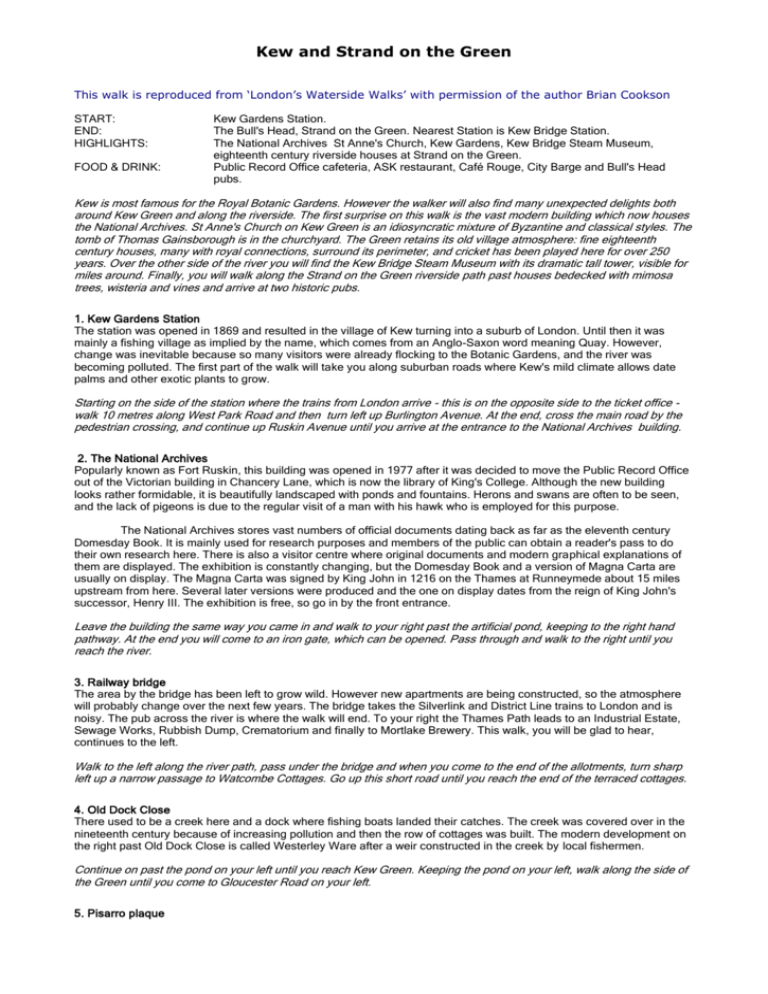
Kew and Strand on the Green This walk is reproduced from ‘London’s Waterside Walks’ with permission of the author Brian Cookson START: END: HIGHLIGHTS: FOOD & DRINK: Kew Gardens Station. The Bull's Head, Strand on the Green. Nearest Station is Kew Bridge Station. The National Archives St Anne's Church, Kew Gardens, Kew Bridge Steam Museum, eighteenth century riverside houses at Strand on the Green. Public Record Office cafeteria, ASK restaurant, Café Rouge, City Barge and Bull's Head pubs. Kew is most famous for the Royal Botanic Gardens. However the walker will also find many unexpected delights both around Kew Green and along the riverside. The first surprise on this walk is the vast modern building which now houses the National Archives. St Anne's Church on Kew Green is an idiosyncratic mixture of Byzantine and classical styles. The tomb of Thomas Gainsborough is in the churchyard. The Green retains its old village atmosphere: fine eighteenth century houses, many with royal connections, surround its perimeter, and cricket has been played here for over 250 years. Over the other side of the river you will find the Kew Bridge Steam Museum with its dramatic tall tower, visible for miles around. Finally, you will walk along the Strand on the Green riverside path past houses bedecked with mimosa trees, wisteria and vines and arrive at two historic pubs. 1. Kew Gardens Station The station was opened in 1869 and resulted in the village of Kew turning into a suburb of London. Until then it was mainly a fishing village as implied by the name, which comes from an Anglo-Saxon word meaning Quay. However, change was inevitable because so many visitors were already flocking to the Botanic Gardens, and the river was becoming polluted. The first part of the walk will take you along suburban roads where Kew's mild climate allows date palms and other exotic plants to grow. Starting on the side of the station where the trains from London arrive - this is on the opposite side to the ticket office walk 10 metres along West Park Road and then turn left up Burlington Avenue. At the end, cross the main road by the pedestrian crossing, and continue up Ruskin Avenue until you arrive at the entrance to the National Archives building. 2. The National Archives Popularly known as Fort Ruskin, this building was opened in 1977 after it was decided to move the Public Record Office out of the Victorian building in Chancery Lane, which is now the library of King's College. Although the new building looks rather formidable, it is beautifully landscaped with ponds and fountains. Herons and swans are often to be seen, and the lack of pigeons is due to the regular visit of a man with his hawk who is employed for this purpose. The National Archives stores vast numbers of official documents dating back as far as the eleventh century Domesday Book. It is mainly used for research purposes and members of the public can obtain a reader's pass to do their own research here. There is also a visitor centre where original documents and modern graphical explanations of them are displayed. The exhibition is constantly changing, but the Domesday Book and a version of Magna Carta are usually on display. The Magna Carta was signed by King John in 1216 on the Thames at Runneymede about 15 miles upstream from here. Several later versions were produced and the one on display dates from the reign of King John's successor, Henry III. The exhibition is free, so go in by the front entrance. Leave the building the same way you came in and walk to your right past the artificial pond, keeping to the right hand pathway. At the end you will come to an iron gate, which can be opened. Pass through and walk to the right until you reach the river. 3. Railway bridge The area by the bridge has been left to grow wild. However new apartments are being constructed, so the atmosphere will probably change over the next few years. The bridge takes the Silverlink and District Line trains to London and is noisy. The pub across the river is where the walk will end. To your right the Thames Path leads to an Industrial Estate, Sewage Works, Rubbish Dump, Crematorium and finally to Mortlake Brewery. This walk, you will be glad to hear, continues to the left. Walk to the left along the river path, pass under the bridge and when you come to the end of the allotments, turn sharp left up a narrow passage to Watcombe Cottages. Go up this short road until you reach the end of the terraced cottages. 4. Old Dock Close There used to be a creek here and a dock where fishing boats landed their catches. The creek was covered over in the nineteenth century because of increasing pollution and then the row of cottages was built. The modern development on the right past Old Dock Close is called Westerley Ware after a weir constructed in the creek by local fishermen. Continue on past the pond on your left until you reach Kew Green. Keeping the pond on your left, walk along the side of the Green until you come to Gloucester Road on your left. 5. Pisarro plaque Note the Victorian houses bordering this side of the Green, with their delicate terracotta mouldings. Kew was always a favourite place for artists to live and work, and you will see two blue plaques on these houses. The plaque on No. 22 is to Arthur Hughes, a minor Pre-Raphaelite painter, and the one on the end house of Gloucester Road is to Emile Pisarro, the French Impressionist. He stayed here in 1892 and painted several Kew scenes. Now cross the main road and head for the church on the other side. 6. St Anne's Church Kew was not big enough to be a Parish until 1770, but the inhabitants wanted their own church, so they petitioned Queen Anne to allow them to build one. She gave her permission and £100 towards the cost. The church was completed in 1714 and was dedicated to St Anne, presumably to honour Queen Anne herself. It is an unusual mixture of Byzantine and classical styles in yellow brick and with arched windows. In the churchyard are several interesting tombs of artists. On the south west side of the church, surrounded by railings, you will see the tomb of Thomas Gainsborough and his family. He never actually lived in Kew, but often stayed here with his friend, Joshua Kirby. Gainsborough's portrait of Joshua Kirby and his wife hangs in the National Gallery. At the east end of the churchyard is the plain rectangular tomb of Johann Zoffany, whose house you will see later across the river in Strand on the Green. He painted The Last Supper, using local people for models of the apostles, and himself as St Peter. The painting was intended to hang in St Anne's, but when people started using the names of the apostles for the local men who acted as their models, the wife of the man who was the model for Judas objected so strongly that it had to be removed. The painting now hangs in St Paul's Church in Brentford. Leaving the churchyard, cross the road on the south side of Kew Green and walk to the right to the gates in front of No. 47. 7. Original entrance to Kew Gardens The plaque on the right of the gates records that this was the original entrance to the Botanic Gardens. It was in the 1670s that the Capel family started collecting rare trees and plants and thus formed the basis for later development of pleasure gardens by George II's son Frederick. After Frederick's death in 1751 his wife, Princess Augusta, created a botanical garden with the assistance of Lord Bute who lived in No. 37, the large house with the white portico protruding over the pavement. This and most of the houses around this part of Kew Green date from the eighteenth century. Many famous architects, botanists and landscape gardeners have been associated with the later development of the gardens. William Chambers built the Chinese Pagoda for Princess Augusta in 1761, Decimus Burton built the celebrated Palm House in 1844, Capability Brown landscaped the whole area in the 1770s, and Sir Joseph Banks made the Botanic Gardens famous by the introduction of many exotic plants from all over the world. In 1840 Queen Victoria, who seemingly had little interest in gardening, gave Kew Gardens to the nation. Since then it has combined the functions of botanical research centre and tourist attraction. Carry on to the end of Kew Green where the present entrance is located. 8. Kew Gardens The beautiful wrought iron gates you see were constructed in the Jacobean style in 1848, soon after Kew Gardens were taken over by the government. They were designed by Decimus Burton, the architect of the Palm House. Pedestrian entrances flank the large double gate which was originally intended for carriages. Looking through the gates, you can see some specimen trees and the Orangery on the right hand side of the pathway. William Chambers designed this long rectangular building with its tall arched windows in 1761. Well within living memory the entrance fee was one penny, but is now considerably more. Kew Gardens has been given the status of a World Heritage Site and you can spend a whole day here. If you want to finish the walk you should resist the temptation to go in and plan to return another day. Carry on round the north side of the Green until you come to the red brick building with railings in front just before Ferry Lane. 9. Herbarium George III's younger son, the Duke of Cumberland, lived here. He is known as the Butcher of Culloden, having defeated Bonnie Prince Charlie's forces with considerable brutality at Culloden in Scotland in 1745. Today the Herbarium stores dried specimens of all the world's plants and has a research library. It is not open to the public. Just beyond the building is Ferry Lane which used to lead to the ferry which provided a river crossing to Brentford. Today it leads to the car park by the north entrance to the Botanic Gardens. Continue along the north side of the Green to No. 83, called Capel House. 10. Capel House This house is named after the Capel family who originated the gardens in the seventeenth century. The left side of the red brick house dates from the late seventeenth century. You can tell this because the wooden window frames are flush with the brick walls. This was forbidden in London after the Building Act of 1707 which made it obligatory to recess window frames behind the brickwork in order to reduce the risk of fire spreading. The right hand side has been added on later, as you can see by the recessed window frames. The herb garden reminds us of the Capel family's interest in plants. Cricket has been played here on the Green since the time of King George II's son, Prince Frederick. A match took place in 1737 when the prince captained a side against the Duke of Marlborough's team. Needless to say the prince's side won. Turn left up Bush Road. No. 7 on the right used to be a ladies lavatory, but is now a desirable private residence. Carry on until you reach the river. 11. Kew Bridge The first Kew Bridge was built in 1759 by the owner of the ferry, Robert Tunstall. Tolls were charged until 1873 when it came under public control. The present bridge was constructed in 1903 to a design by Sir John Wolfe-Barry, who also erected Tower Bridge. The landing stage for boats downstream to London and upstream to Hampton Court is along the path under the bridge. Now mount the steps which are set back from the river path on this side of the bridge. This takes you on to Kew Bridge itself. Walk over the river to the north side, cross the main road called Kew Bridge Road and turn left towards the tall tower of Kew Bridge Steam Museum. 12. Kew Bridge Steam Museum This used to act as a pumping station where massive Cornish beam engines pumped water to West London for over a century. Today water is supplied from reservoirs further upstream in the area around Staines, but you can see many of these Cornish engines in operation at the weekend. There is also an exhibition on the history of water supply from Roman times to the modern Thames Ring Main. Go back to the traffic lights at the end of Kew Bridge and cross over Kew Bridge Road to Strand on the Green. Walk along this road towards the river and then continue to the Café Rouge. 13. Rose Cottage Just past Café Rouge is Rose Cottage, once the home of Nancy Mitford. She moved here in the 1930s after her marriage and joked that she would have to become an old housewife. She was one of the daughters of Baron Rosedale. She was the author of a biography of Mme. De Pompadour, and invented the now outmoded terms 'U' and 'Non U' referring to language usage and social behaviour. Of her sisters, Jessica was a Communist, Unity a Nazi, and Diana married Oswald Mosley. This small painted cottage seems an unlikely setting for such controversial characters. Just past Rose Cottage, the Thames Path branches to the right of the road. Leave the road here and take this path along the side of the river. Note the high steps up to the houses and the rich variety of architectural styles and vegetation as you walk on to No. 65. 14. Zoffany's house The towpath here is frequently flooded, which is why the houses have steps up to the entrance doors, and in some cases iron water barriers. Partly due to this there is a delightful variety of flowers and shrubs including fig, vine, wisteria and mimosa. No. 65 was the home of Johann Zoffany between 1790 and 1810. It dates from the late seventeenth century with its ornate doorcase and well defined brickwork. Note also the converted gas lights by the door. Zoffany was a prolific artist and friend of Kings, Queens, Maharajahs and actors, many of whose portraits he painted. Walk on to the City Barge Pub. 15. City Barge This ancient pub was known as the Navigator's Arms until the Lord Mayor moored his ceremonial barge here for the winter in the nineteenth century. It was then renamed the City Barge. See the steel door in front of the bar entrance, which prevents flooding by the Spring tides. Walk under the Railway Bridge and stop at the Bull's Head Pub 16. Bull's Head This historic pub was where Oliver Cromwell once held a meeting, only to be surprised by Royalist forces. It is said that he managed to escape by a secret passage under the river to the island in the middle of the river, which is therefore known as Oliver's Eyot. The word 'Eyot' is pronounced like 'eight' and many of the islands on the Thames are referred to by this ancient name.If the tide is out it is possible to descend on to the river bed here. You may wish to refresh yourself in one of these pubs as there is no immediate access to public transport. The nearest Mainline Station is Kew Bridge which you reach by retracing your steps along the Thames Path and then crossing back over Kew Bridge Road and walking a short distance to your right. The nearest Underground Station is Gunnersbury. Carry on along the Thames Path past the Bull's Head and turn left up Magnolia Road. Carry on over the Railway Bridge and follow the roads to the Underpass under the Great West Road. Turn left into Harvard Road which takes you to the car park by Gunnersbury Underground Station.
